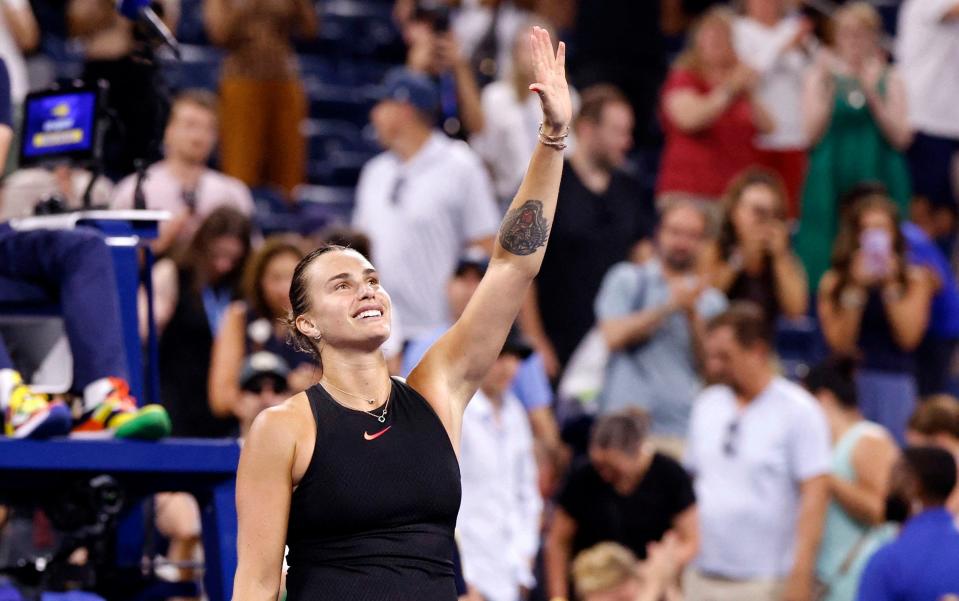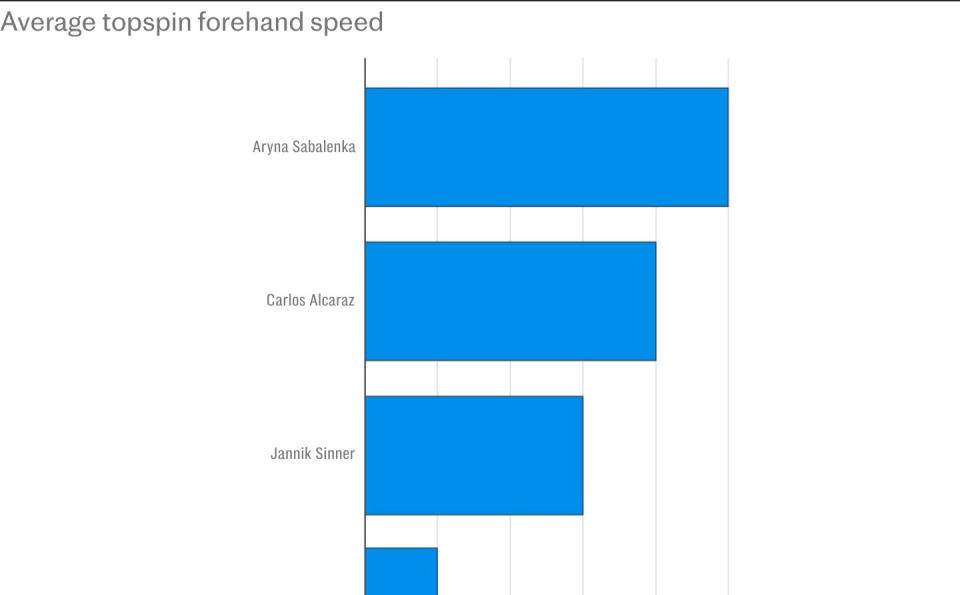Aryna Sabalenka’s dominant run to the semi-finals at this year’s US Open may not come as a complete surprise when you comb through her stats: the Belarusian is striking the ball harder than top male players at Flushing Meadows.
She has built her game around her powerful forehand, swatting her opponents aside with terrifying ease that would make most male players squirm. The world No 2 has recorded average forehand topspin speeds of 129 kph in New York, bettering those of the modern day ‘big three’ of Carlos Alcaraz (127 kph) Jannik Sinner (126 kph) and Novak Djokovic (122 kph).
Talk about hitting like a girl. Sabalenka seemed somewhat embarrassed when she was quizzed about her not-so-secret weapon following her fourth-round victory over Elise Mertens earlier in the week.
“I saw my stats on my forehand and I actually can’t believe it’s that fast,” she giggled during her on-court interview. “It felt kind of uncomfortable being at the top and even hitting harder than guys. That’s a really interesting stat.”


The source of her sheepishness might have stemmed from recent events. Days earlier, Chris Evert had been accused of gender stereotyping after describing how Karolina Muchova “plays like a guy” while commentating on the Czech’s second-round victory over Naomi Osaka.
“She plays like a guy. She wants to play like a guy. The guys have bigger serves than the women, they have better volleys for the most part, they move a little bit better,” the 18-time major champion said of Muchova.
Her fateful comments might have been well intentioned – for Muchova later revealed she modelled her game off her childhood hero Roger Federer – but Evert still found herself at the centre of a social media storm, with Ons Jabeur even calling her out on X, formerly Twitter. “Muchova is an amazingly talented player. She doesn’t have to be a guy to have great serve, volley or movement. Can we please stop stereotyping based on gender?” the two-time Wimbledon finalist wrote.
Comparisons between sportsmen and women are often futile due to basic differences in physiology. Biology dictates men hit the ball harder but therein lies the reason why Sabalenka’s ferocious forehand is a point of intrigue – she is a rare example of a woman who is currently outperforming her male counterparts in elite sport.
The shot has long been one of Sabalenka’s most prized possessions and has echoes of Serena Williams’ formidable groundstrokes that ushered in a new era for women’s tennis. It is also perfectly suited to the pacey American hard courts and a skill the two-time slam champion has been priming for all year, helped by a conditioning-heavy training regime, of which she has shared snippets of on her Instagram page.
In the first round of this year’s French Open, Sabalenka recorded a forehand top speed was 125 kph, usurping Jannik Sinner’s own speed of 122kph. It is no coincidence she is the youngest woman to reach four consecutive singles semi-finals at the US Open since Venus Williams in 2002, having also made the quarter-final stage in her last eight Grand Slams she has entered.


This is a woman who has been channelling her queen energy in a bid to make up for unfinished business after her teary defeat to Coco Gauff in last year’s US Open final, when footage emerged of her smashing her racquet in the locker room after the trophy ceremony.
Her frustration of falling short 12 months ago looks to have all but ebbed away. Sabalenka has cut a jubilant, smiling figure in New York as she edges closer in her bid to become the first woman since Angelique Kerber in 2016 to win the hard-court major titles at the Australian Open and US Open.
After her second-round victory over Lucia Bronzetti, she spotted a young girl who was sporting an identical purple outfit to the one Sabalenka wore during her match and ended up stealing the show. In one of the most heartwarming scenes of the tournament, Sabalenka swept the young superfan up – whom she dubbed her ‘mini me’ – and posed for photos with her on court.
For someone who has endured an up-and-down relationship with the Flushing Meadows crowds over the years, Sabalenka appears to be making a concerted effort this year to win over supporters.
After dispatching China’s Olympic champion Zheng Qinwen in an hour and 13 minutes to set up a semi-final meeting with American Emma Navarro, she joked with the crowd that she would treat them to a beverage or two if they rooted for her against Navarro. “Drinks on me tonight?” asked Sabalenka, who is a heavy favourite to add to her two Australian Open triumphs. “Drink on me and please give me some support in the next match.”
Even if her plea falls on deaf ears, Sabalenka need not worry – her predatory forehand has already earned plenty of admirers in New York.
Source Agencies


